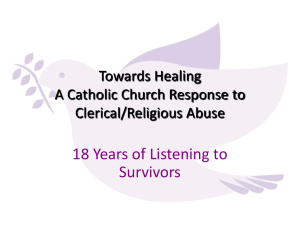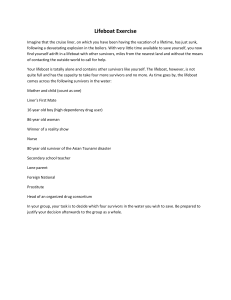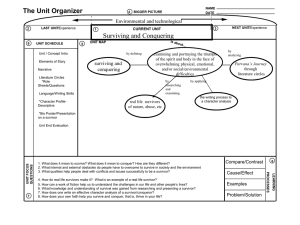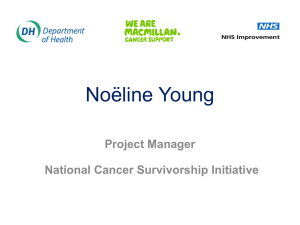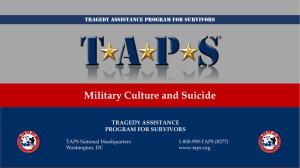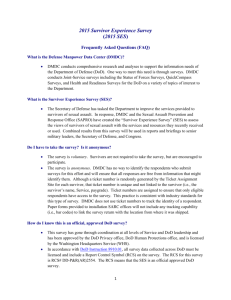What works for cancer survivors?
advertisement
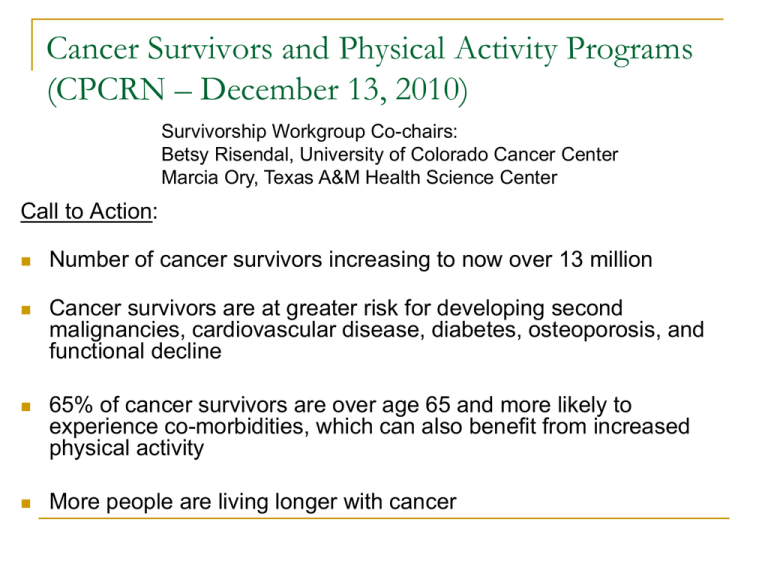
Cancer Survivors and Physical Activity Programs (CPCRN – December 13, 2010) Survivorship Workgroup Co-chairs: Betsy Risendal, University of Colorado Cancer Center Marcia Ory, Texas A&M Health Science Center Call to Action: Number of cancer survivors increasing to now over 13 million Cancer survivors are at greater risk for developing second malignancies, cardiovascular disease, diabetes, osteoporosis, and functional decline 65% of cancer survivors are over age 65 and more likely to experience co-morbidities, which can also benefit from increased physical activity More people are living longer with cancer Cancer Survivors and Physical Activity Programs: What Now, and Why Now? Institute of Medicine (IOM) delivers a nationwide report of the numerous health issues of cancer survivors and the potential benefits of lifestyle modifications (Lost in Translation, 2005) The American Cancer Society reissued its guide for Informed Choices on Nutrition and Physical Activity During and After Cancer Treatment (2006) Recent systematic and meta-analyses suggest that physical activity improves survival American College of Sports Medicine passed guidelines to promote physical activity in this group (highlight of the Biennial Cancer Survivorship Meeting in June, 2010) Physical Activity Programs for Cancer Survivors are Moving Ahead….. Certifications for fitness trainers working with cancer survivors are available from ACSM and others YMCA, LAF promoting programs at the national and local level Over 600 programs identified from our Internet search in the 10 CPCRN states) However, physical activity interventions available on RTIPS do not target cancer survivors (adaptation!) Cancer Survivors and Health Behavior: What do we know that might affect adaptation? Preferred Channels for Delivery: “As with intervention timing, there are relatively few studies that have explored patient preferences regarding intervention delivery channel and even fewer that have compared the relative efficacy of different methods.” Intervention Components: “Most health promotion interventions among cancer survivors have reported favorable findings, although more research is needed to determine optimal approaches, not only with regard to delivery channel, but also to timing, pairing, of behavioral components, and so forth.” Demark-Wahnefried, W. and Jones, LW. Hematol Oncol Clin N Am 22 (2008) 319–342 Cancer Survivors and Health Behavior: What do we know that might affect adaptation? What works for cancer survivors? “There is much scope for offering interventions based on theories found to be useful in promoting behavior change in non-cancer populations.” Interventions based on the Transtheoretical Model have been found to be effective in improving fitness, smoking cessation, and reducing pain and fatigue. Studies with Motivational Interviewing interventions have produced mixed, inconclusive results in this population. Interventions based on Social Cognitive Theory constructs have been effective in increasing walking, daily fruit and vegetable intake, and reducing body mass. Identification of Core Intervention Components: …”it is possible to identify both the theories that have been applied in the development of specific interventions and their potential utility to intervention efficacy in cancer survivors.” Pinto, B. and Floyd A. Seminars in Oncology Nursing, Vol 24, No 3 (August), 2008: pp 153-163 Translation/Dissemination of Physical Activity Programs in Cancer Survivors Translating Physical Activity Interventions for Breast Cancer Survivors into Practice: An Evaluation of Randomized Controlled Trials. White et al., 2009 This review was designed to provide a quantitative estimate of the reporting of both internal and external validity in recent studies of physical activity in breast cancer survivors, using the RE-AIM framework. “….no studies reported methods to identify the target delivery agent, delivery agent, inclusion/exclusion criteria, adoption rate, or representativeness of study settings to the broader population of clinical settings that would ultimately deliver such an intervention.” “ The reporting of implementation indicators of physical activity interventions at the organizational level is lacking in both the general literature and the physical activity and breast cancer literature.” White S.M., McAuley, E., Estabrooks P., Courneya, K. Ann. Behav. Med. (2009) 37:10– 19 Why a Scoping Study: Purpose and Definitions Methodology* originating in the social sciences to produce a review that is more useful to policy makers, practitioners and service users than systematic reviews or meta-analyses (utility) Addresses effectiveness piece (“how”) Unlike systematic reviews, includes wide range of study designs to document the extent, nature and range of activity and gaps Includes grey literature, such as unpublished progress reports or evaluation plans (electronic databases, internet, research registries) *Best practices for conducting this type of review: Arksey, H. and O'Malley, L. (2005) Scoping studies: towards a methodological framework, International Journal of Social Research Methodology, 8, 1, 19-32. Goal and Significance of Scoping Study Perform a scoping study to summarize and synthesize the implementation literature (i.e. published and grey literature) of health promotion programs for cancer survivors. The results of this scoping study can be used as a guide for public health professionals, funders, and practitioners when planning and implementing programs in this population. Research questions that this scoping study will answer: What current physical activity interventions have been implemented and/or designed in cancer survivor populations? How have evidence-based physical activity programs been adapted for this population? What are the components and results of these studies? How have these interventions been translated for use on a large scale or for the cancer survivor population? Scoping Study Rubric for Published Literature Title, Citation Description of intervention Study Design Dose/Intensity/Duration Population/Cancer Type Setting Program/sample size and demographics Results/Outcomes What else could we ask to discern adaptation? Scoping Study: Steps as defined by best practices Stage 1. Identifying the research question Stage 2 Identifying relevant studies* Stage 3 Study selection Stage 4 Charting the data Stage 5 Collating, summarizing and reporting the results. Progress to Date Criteria for inclusion: Databases used - MEDLINE, PubMed, Internet “Google” search for “grey literature” Inclusion Criteria: Since the goal of this study is to describe and inform program implementation strategies, the study or report must include a description of the components of the intervention used and (if applicable) the population studied. Exclusion Criteria: Literature and reports prior to 1980 will be excluded. Key Words: “cancer survivor evidence based exercise” 36 results on 8/22/2010 “cancer survivor exercise” 494 results on 8/18/2010 “cancer survivor exercise health promotion” 46 results on 8/23/2010 “cancer survivor exercise translation” 3 results on 8/23/2010 “cancer survivor exercise implementation” 5 results on 8/23/2010 UPDATE: So far in our review, 69 OF THESE MEET INCLUSION CRITERIA Translation and Dissemination Framework of Relevance to Survivorship Workgroup Activities: CFIR (Damschroder) Consolidated Framework: intervention characteristics, outer setting, inner setting, characteristics of the individuals involved, and the process of implementation Will this serve as a general framework for this activity? It is unlikely that the articles we review will have detail on the various constructs by provides a general guide We can indicate what we do find n the literature We can design future efforts to obtain more detailed information Scoping Study Stages, Collaboration and Action Steps Stages*: 1-Identifying the research question 2-Identifying relevant studies 3-Study selection 4-Charting the data 5-Collating, summarizing and reporting the results CPCRN Involvement: The survivorship workgroup has helped frame the research question. We have heard from some people who are interested in participating and invite others to get in touch with us if they are interested. Action Plan: More details will be discussed on a survivorship workgroup call in January. *Arksey, H. and O'Malley, L. (2005) Scoping studies: towards a methodological framework, International Journal of Social Research Methodology, 8, 1, 19-32. Review of Survey Activities Colorado has 17 surveys completed -50% response rate. Colorado started key informant interviews Utilizing the results from the Colorado key word search, Texas is identifying potential survey sites and obtaining IRB approvals— this will be co-sponsored by Cancer Alliance of Texas 2 additional CPCRN sites have expressed interest
